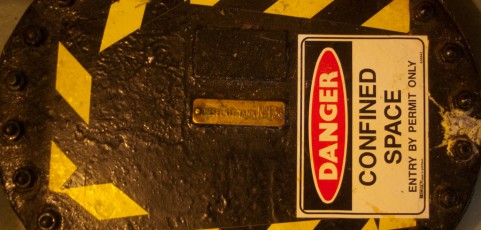When it comes to working in confined spaces, there are several vital issues that need to be considered to ensure the quality of the air you’re breathing. It should be monitored prior to entering any space as well as working within it. It’s vital to know the amount of oxygen that will be available along with any contaminants that could threaten safety. Properly used, gas detection monitors can save lives. Here are 5 facts you should know.
1. What is a confined space?
OSHA regulations 29 CFR 1910 define this as any space large enough for employee entry which also has limited means of entry or exit and is not designed for continuous occupancy. Permit-requires space are any confined space that:
- Has the potential to contain hazardous gases;
- Could have materials that might drown or smother employees;
- Is configured with angles or narrow openings that could trap or smother a person;
- Contains any recognized safety or health hazard.
All such spaces must be equipped with a confined space monitor. Some examples of a confined space might be sewers, silos, bins, tanks, tunnels, and ventilation or drainage systems.
2. Hazardous gas
Learn all the possibly dangerous gases that could be encountered in that space, including deficient (asphyxiation) or enriched (explosive) oxygen levels. This is important to selecting the right monitors to ensure safety. You need a monitor capable of detecting OSHA-defined hazards such as oxygen, flammable gases, and toxic gases used or formed as a by-product of industrial processes. Monitors should also be capable of continuous operation to ensure safety, not just initial readings.
3. Technology
It is important that you understand the different types of gas monitors and their appropriate use, such as catalytic diffusion, electrochemical, or infrared monitors, all of which have varying degrees of value in assuring safety under different conditions. It’s also important to understand feedback from the confined space monitor via displays, electronic signals, alarms, or other means to best alert confined space workers and other employees to emergency situations.
4. Maintenance and Calibration
Proper calibration and maintenance of your monitors is import to assure accurate readings and troubleshoot any instrument problems. Familiarity with keeping devices in peak operation, such as scheduled calibrations, battery checks, and proper cleaning of sensors are important as incorrect reading could endanger lives.
5. Operation
All employees, including maintenance workers and supervisors, should receive adequate training on how to read and maintain their confined space monitors, particularly portable instruments which must be at peak efficiency despite changing environments and the bumps and jostling that result from constant movement. Monitors and training should also include any complementary equipment such as probes, carrying cases, battery chargers, and other accessories, including calibration stations and docking stations.
Educating everyone concerned is the best way to ensure everyone stays safe.
Choosing the right instrument, implementing training programs, familiarity with OSHA requirements, and understanding of the manufacturer services supporting your monitors will prove invaluable in protecting workers in confined spaces.

